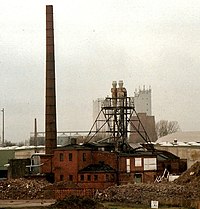Cyclonic separation

Imagine that you have a big box and you pour in some sand and a handful of pebbles. You shake the box around and all the sand and pebbles mix together. To separate the sand from the pebbles, you might just start picking them out with your fingers one by one. This would take a lot of time and energy, so instead, let's try using a tool called a cyclone.
A cyclone is like a big funnel that you attach to the top of the box. You turn on the machine, and air starts to rush in from the top of the funnel, and moves in a circular motion, like a little tornado.
As the air spirals, it picks up all the particles inside the box and pulls them up into the funnel. As the particles spiral up, they are separated by their weight. The heavier pebbles are pulled towards the outside of the cyclone because they have more momentum and centrifugal force. The lighter sand stays in the center, and moves upwards where it eventually falls out of the cyclone and into a separate container.
This process works because of the physical principles of gravity and centrifugal force. Once the particles are picked up off the ground, they have the same force as the moving air, and will follow the same path as it moves. The cyclone creates a vortex, or circular pattern, where the heavier particles are flung towards the outer walls because they have more mass and momentum, while the lighter particles are left in the center because they have less force.
This technique of separating particles with a cyclone is used for many different purposes, such as in industrial manufacturing, agriculture, and even in space exploration! It's a quick and efficient way to separate mixtures, which helps people save time and energy.
A cyclone is like a big funnel that you attach to the top of the box. You turn on the machine, and air starts to rush in from the top of the funnel, and moves in a circular motion, like a little tornado.
As the air spirals, it picks up all the particles inside the box and pulls them up into the funnel. As the particles spiral up, they are separated by their weight. The heavier pebbles are pulled towards the outside of the cyclone because they have more momentum and centrifugal force. The lighter sand stays in the center, and moves upwards where it eventually falls out of the cyclone and into a separate container.
This process works because of the physical principles of gravity and centrifugal force. Once the particles are picked up off the ground, they have the same force as the moving air, and will follow the same path as it moves. The cyclone creates a vortex, or circular pattern, where the heavier particles are flung towards the outer walls because they have more mass and momentum, while the lighter particles are left in the center because they have less force.
This technique of separating particles with a cyclone is used for many different purposes, such as in industrial manufacturing, agriculture, and even in space exploration! It's a quick and efficient way to separate mixtures, which helps people save time and energy.
Related topics others have asked about:
